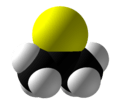Thioacetone
 | |||
| |||
| Names | |||
|---|---|---|---|
| IUPAC name
2-Propanethione | |||
| Identifiers | |||
3D model (JSmol) |
|||
| ChemSpider | |||
PubChem CID |
|||
| |||
| |||
| Properties | |||
| C3H6S | |||
| Molar mass | 74.14 g·mol−1 | ||
| Appearance | Brown liquid | ||
| Melting point | 40 °C (104 °F; 313 K) | ||
| Boiling point | 80–90 °C (176–194 °F; 353–363 K) | ||
| Hazards | |||
| Main hazards | Odor, skin irritant | ||
Except where otherwise noted, data are given for materials in their standard state (at 25 °C [77 °F], 100 kPa). | |||
| Infobox references | |||
Thioacetone is an organosulfur compound with the chemical formula (CH3)2CS. It is a lightly studied compound. The compound has been isolated as an orange or brown liquid at low temperatures.[1] Above −20 °C (−4 °F), thioacetone readily converts to a polymer and a trimer.[2] Thioacetone is associated with an extremely potent, unpleasant smell.
Preparation
Thioacetone is usually obtained by cracking the cyclic trimer [(CH3)2CS]3. The trimer is prepared by pyrolysis of allyl isopropyl sulfide or by treating acetone with hydrogen sulfide in the presence of a Lewis acid.[3][4] The trimer cracks at 500–600 °C (932–1,112 °F) to give the thione.[1][5]
Thioacetone trimer
The trimer of thioacetone is a white or colorless compound with a melting point of 24 °C (75 °F), near room temperature. It also has a disagreeable odor.[2] It is also known as 1,1,3,3,5,5-hexamethyltrithiane.
Odor
Thioacetone has an intensely foul odor. Like many low molecular weight organosulfur compounds, the smell is potent and can be detected even when highly diluted.[6] In 1889, an attempt to distill the chemical in the German city of Freiburg was followed by cases of vomiting, nausea and unconsciousness in an area with a radius of 0.75 kilometres (0.47 mi) around the laboratory due to the smell.[7] British chemists at the Whitehall Soap Works in Leeds noted in an 1890 report that dilution seemed to make the smell worse and described the smell as "fearful".[8] Thioacetone is considered a dangerous chemical due to its extremely foul odor and ability to render people unconscious, induce vomiting, and be detected over long distances.
In 1967, Esso researchers repeated the experiment of cracking thioacetone, at a laboratory south of Oxford, UK. They reported their experience as follows:
Recently we found ourselves with an odour problem beyond our worst expectations. During early experiments, a stopper jumped from a bottle of residues, and, although replaced at once, resulted in an immediate complaint of nausea and sickness from colleagues working in a building two hundred yards [180 m] away. Two of our chemists who had done no more than investigate the cracking of minute amounts of trithioacetone found themselves the object of hostile stares in a restaurant and suffered the humiliation of having a waitress spray the area around them with a deodorant. The odours defied the expected effects of dilution since workers in the laboratory did not find the odours intolerable ... and genuinely denied responsibility since they were working in closed systems. To convince them otherwise, they were dispersed with other observers around the laboratory, at distances up to a quarter of a mile [0.40 km], and one drop of either acetone gem-dithiol or the mother liquors from crude trithioacetone crystallisations were placed on a watch glass in a fume cupboard. The odour was detected downwind in seconds.[9]
See also
- Thiobenzophenone, a thioketone that can be isolated as a solid
- Bromoacetone
- Chloroacetone
- Fluoroacetone
- Iodoacetone
References
- 1 2 V.C.E. Burnop; K.G. Latham (1967). "Polythioacetone Polymer". Polymer. 8: 589–607. doi:10.1016/0032-3861(67)90069-9.
- 1 2 R.D. Lipscomb; W.H. Sharkey (1970). "Characterization and polymerization of thioacetone". Journal of Polymer Science Part A-1: Polymer Chemistry. 8 (8): 2187–2196. doi:10.1002/pol.1970.150080826.
- ↑ Bailey, William J.; Chu, Hilda (1965). "Synthesis of polythioacetone". ACS Polymer Preprints. 6: 145–155.
- ↑ Bohme, Horst; Pfeifer, Hans; Schneider, Erich (1942). "Dimeric thioketones". Berichte der Deutschen Chemischen Gesellschaft. 75B (7): 900–909. doi:10.1002/cber.19420750722. Note: This early report mistakes the trimer for the monomer
- ↑ Kroto, H.W.; Landsberg, B.M.; Suffolk, R.J.; Vodden, A. (1974). "The photoelectron and microwave spectra of the unstable species thioacetaldehyde, CH3CHS, and thioacetone, (CH3)2CS". Chemical Physics Letters. 29 (2): 265–269. doi:10.1016/0009-2614(74)85029-3. ISSN 0009-2614.
- ↑ Derek Lowe (June 11, 2009). "Things I Won't Work With: Thioacetone". In The Pipeline.
- ↑ E. Baumann & E. Fromm (1889). "Ueber Thioderivate der Ketone". Berichte der Deutschen Chemischen Gesellschaft. 22 (2): 2592–2599. doi:10.1002/cber.188902202151.
- ↑ Chemical News and Journal of Industrial Science. Chemical news office. 1890. p. 219.
- ↑ Derek Lowe (June 11, 2009). "Things I Won't Work With: Thioacetone". In The Pipeline.
External links
- Thioacetone, NIST
- Trithioacetone, Aldrich


